Since 2017, IRP activities for Area 2-1 (100 hectares) and Area 2-2 East (108 hectares) (herein after referred to as “Zone B - Phase 1&2) have been implemented starting from construction of infrastructure at Relocation Site (RS) to activities for restoration of economic condition through a series of participatory workshops and discussion with Project Affected Peoples (PAPs), the Government of Myanmar (GoM), Yangon Regional Government, Thilawa Special Economic Zone Management Committee (TSMC), Township related departments, Civil Society Organizations (CSO), JICA Expert Team (JET) and resource people, for development of positive and sustainable living conditions and to implement priority actions for livelihood restoration according to IRP action plan for Zone B – Phase 1&2.
Applying National Registration Card (NRC)
Many PAPs from Zone B - Phase 1&2 did not possess NRCs when resettlement program was implemented in 2017. Without NRCs, people were not able to work in Thilawa Special Economic Zone (TSEZ), to open a bank account in banks, to travel around legally and to make other official procedure in daily life. IRP supported them during application of NRC and census retransferring from Zone B - Phase 1&2, the Project Affected Area, to RS in collaboration with related Village Tract Administrators, Township General Administration Department and Township Immigration Department in 2018 and in 2019. To be exact, GoM supported 25 households during census transferring process application and 3 PAPs, who lost their NRC, and 8 PAPs, who wanted to apply the new ones, during NRC application to Township Immigration Department as IRP activities.
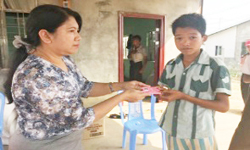 |
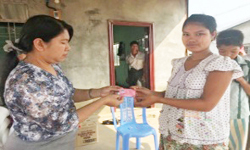 |
 |
Figure: NRC receiving by Zone B - Phase 1&2 PAPs
Transferring School Children to a Nearby School
Concerning children of PAHs who were relocated to the RS of Zone B - Phase 1&2, 27 number of children had to be transferred to a high school (sub) nearby relocation site.16 children were transferred to a this school by May, 2017 and 11 children were transferred to this school by May, 2018 with a support of Thilawa SEZ Management Committee (TSMC) and the Ministry of Education. PAHs expressed satisfaction about the fact that their children were going to a school.
Job Readiness Training, Vocational Training and Job Matching
(1) Job Readiness Training
The main purpose of job readiness training is to ensure that PAPs are prepared for wage labor, particularly in a context where many were either heavily engaged in cultivation/livestock production and/or casual labor. Job readiness training is provided to PAPs to support them in securing and maintaining employment. It is also designed to help participants develop good work habits that facilitate their ongoing success. It is provided either by a third party service provider or the prospective employer when the PAP is matched for employment.
Two days job readiness training were conducted to Zone B- Phase 1&2 PAPs by investors in TSEZ such as Alidac Healthcare Myanmar Co., Ltd and Foster Electric Co., Ltd in response to request from TSMC and Myanmar Japan Thilawa Development Limited (MJTD) in May, 2018. JET also supported this training technically by preparing necessary presentation materials and TSMC supported by giving daily allowances and transportation arrangement for participants to promote their participation.
The purposes of this training are to support PAPs to be easy on finding jobs which are suitable for them and to prepare necessity before they start working. 23 numbers of participants attended the training in total. Curriculum includes how to find suitable jobs, how to prepare CV, interview tips, good employee’s behaviors and general rules and principles in factories.
 |
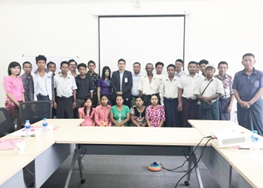 |
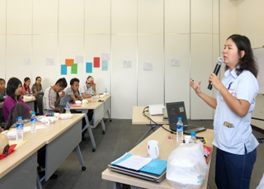 |
| Lecture by Alidac Healthcare Myanmar Co.,Ltd | Participants in Job Readiness Training | Lecture by Foster Electronic Co.,Ltd |
Figure: Job Readiness Training for Zone B - Phase 1&2 PAPs
(2) Vocational Training
Vocational trainings are provided to PAPs to support those interested in securing employment at the SEZ or in another formally organized work environment. Vocational training is a key element to provide PAPs with the necessary skills that can enable them to be matched with a job at a relevant employer, within the SEZ and/or nearby. Vocational training is normally directly provided by prospective employers or organised through a third party service provider, as relevant.
IRP has provided a wide range of vocational trainings including a driving training and two tailoring trainings to Zone B – Phase 1&2 PAPs. A driving training has been supported by TSMC, cooperated with the Central Institute of Transport and Communication in July, 2018. There were 14 numbers of participants who attended the driving training and they could get driving license after the training in case they met criteria. Some participants could earn money by driving their relatives’ cars after attending the training.
In July, 2018, the first time basic and advanced tailoring training was organized by MJTD for Zone B – Phase 1&2 PAPs as one of TSEZ’s CSR activities. In April 2019, the second time basic and advanced tailoring training was organized as one of IRP activities in collaboration with the Ministry of Social Welfare, Relief and Resettlement. A professional sewing trainer from the Department of Social Welfare came to Kyauktan township to conduct a training to Zone B - Phase 1&2 PAPs and their relatives in the second time training. The total number of participants in the first and in the second time training are 13 each. TSMC lent each PAP with a sewing machine after each training. Most participants could earn money by sewing at their homes or by working at garment factories at TSEZ or at local industrial zone near TSEZ or garment factories near TSEZ after attending these trainings.
 |
 |
 |
| Trainees in he basic Driving Training in 2018 | Tailoring Training in 2018 | Tailoring Training in 2019 |
Figure: Driving Training in 2018 and Tailoring Training in 2019 for Zone B - Phase 1&2 PAPs
(3) Job Matching
As of July, 2019, 102 numbers of companies got permission from TSEZ at industrial area of Zone A and B; 72 numbers of companies are under operation and 18 numbers of companies are under construction. Infrastructure development at Zone A and Zone B – Phase 1&2 are completely finished. 98 % of Zone A is occupied by 85 investors from 17 different countries and 64 % of Zone B - Phase 1 is occupied by 13 investors of various industries from 7 different countries. Zone B – Phase 2 is under infrastructure construction.
Factories under operation and construction companies have been recruiting local workers to work at the TSEZ. The IRP has supported Zone B – Phase 1&2 PAPs to disseminate job vacancy information at TSEZ, to prepare CVs and has coordinated job interviews for them, working in close coordination with the Yangon Regional Government (YRG), TSMC, MJTD, investors, contractors and sub-contractors according to the following figure about the communication flow for job matching included in IRP action plan. The IRP has been tracking the progress of PAPs who have expressed interest in working at the TSEZ and those that have secured jobs. 36 numbers of PAPs are working at TSEZ and 41 numbers of PAPs have applied job in TSEZ as of at the end of June, 2019.

Infrastructure Improvement at the Relocation Site
At the RS of Zone B – Phase 1&2, there was an issue about overflow of wastewater from septic tanks depending on the number of persons who used toilets especially during the rainy season in 2017. In order to solve this issue, TSMC conducted investigation such as measuring ground level and discussing with residents several times. JET also supported TSMC to solve this issue. As a result of investigation, it was found that the groundwater level is higher in the rainy season and due to rain water flowing into the soil. This issue has been solved by installing an extra septic tank with an overflow pipe to drainage in each plot at the end of June, 2018 as per below.

Figure: Increasing the Number of Septic Tanks for Toilets in Zone B - Phase 1&2 RS
Another issue is that some drainage in RS were damaged due to heavy trucks. All damaged drainage were repaired in February, 2019 as per below.
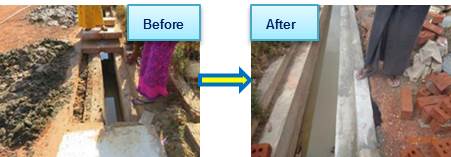
Figure: Drainage Improvement in Zone B – Phase 1&2 RS
In June, 2019, relocated plots at Zone B – Phase 1&2 were flooded due to the fact that two drainages from the RS to a nearby creek were blocked with the soil filled by the original land owner of the RS. Therefore this issue was solved by negotiation with him to remove the soil which blocked these drainages. The problem of flooding to the relocated plots was solved by this method.
 |
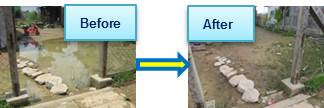 |
Figure: Flooding Problem Solved in Zone B - Phase 1&2 RS
Another issue was occurred at the iron removal plant in the water supply system of RS of Zone B – Phase 1&2 due to the water quality of groundwater especially iron contents for water supply system. This problem was solved in short term by cleaning the iron removal plant every month since April, 2018 to Nov, 2018 due to accumulation of sediment containing iron hydroxide in the iron removal plant. At the same time, water quality has been analyzed at the laboratory for four times in 2018 to check the water quality of the water supply system.
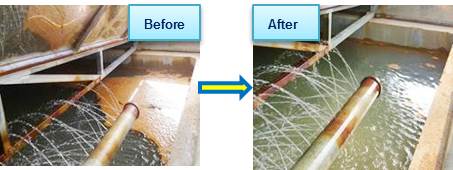
Figure: Cleaning of the Iron Removal Tank in the Water Supply System in Zone B – Phase 1&2 RS
In order to solve this water quality problem in long term, JET proposed to dig a new tube well by investigating a new location to dig based on information about nearby aquifer such as depth of an aquifer, where a good quality of groundwater could be taken for water supply. After a series of discussions with Zone B – Phase 1&2 PAPs, a new tube well was dug at the depth less than the depth of existing tube well nearby the existing tube well in Jan, 2019. When the water quality from the new tube well was tested at a laboratory, it was found that the amount of iron content in the new tube well is less than that in the existing tube well and the water quality was good enough for using. Therefore, the new tube well is used for water supply system for the RS of Zone B – Phase 1&2.
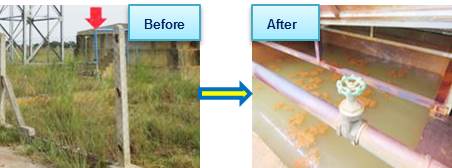 |
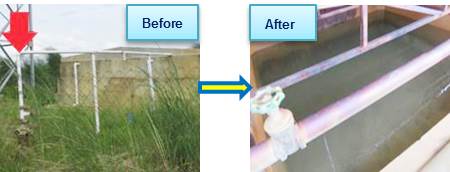 |
||
| Existing Tube Well | Water from the existing Tube Well | A new Tube Well | Water from a new Tube Well |
Figure: Existing Tube Well and a New Tube Well in Zone B – Phase 1&2 RS
Social Welfare Support Program
Vulnerable People Program
Vulnerable or at-risk displaced people require additional livelihood assistance to restore their livelihoods to at least pre-project levels. Therefore IRP gives the first priority to vulnerable people to give additional livelihood support. Vulnerable People Program has been provided to vulnerable PAHs/PAPs in addition to the entitlements under the RWP. These measures are designed to assist vulnerable PAPs to successfully participate in livelihood restoration activities.
In other words, Vulnerable People Program is a key element of the component 1 of IRP: support for restoration of economic conditions through a combination of activities for enhancement of income earning opportunities and household account management. As shown in the following figure, the Vulnerable People Program in IRP comprises the following steps.
- Additional Basic Living Provisions;
- Choosing an IRP Stream;
- Intensive IRP Support
All assistance under the Vulnerable People Program has been provided at the household level (e.g., to vulnerable people and their families). It is a critical point for local government including Village Tract/Ward and Township related departments and authorities to be involved in development of the specific activities to be implemented under the Vulnerable People Program.

Figure: Vulnerable People Program in IRP
Vulnerable People/Households in Zone B – Phase 1&2 have been provided with basic living provisions since March 2018 to until. Criteria to identify Vulnerable People has been decided through a series of consultation with seniors in Zone B – Phase 1&2, local authority and PAPs based on the IRP Action Plan and Resettlement Work Plan. As of June 2019, there are 23 number of vulnerable households and they have been provided with basic living provisions every month by TSMC.
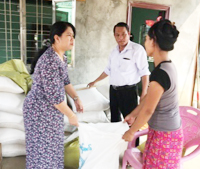 |
 |
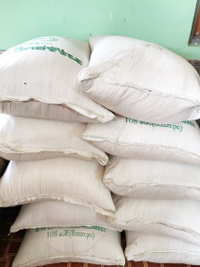 |
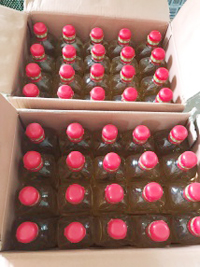 |
Figure: Providing Basic Living Provisions to Vulnerable People
At the same time, TSMC has conducted the quarterly monitoring survey to vulnerable households since September 2018 to monitor livelihood of vulnerable households and four number of monitoring was done until June 2019.
 |
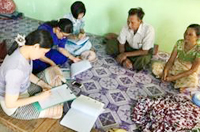 |
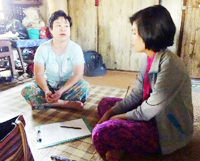 |
| In June, 2019 | In Dec, 2018 | In Dec, 2018 |
Figure: Conducting Quarterly Monitoring Survey with Zone B – Phase 1&2 Vulnerable Household
There has been a social welfare program to support relocated Zone B – Phase 1&2 PAPs with cash assistance; when there is a baby born, a funeral, an accident and a serious illness was happened in their family members since April, 2019.
Secure ownership of the Land Property
Providing the Land Permit to relocated Zone B - Phase 1&2 PAPs
TSMC held the land permits for relocated land giving ceremony to all 91 relocated households from Zone B – Phase 1&2 in March 2019 as their land property.
 |
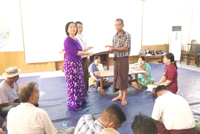 |
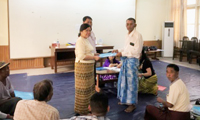 |
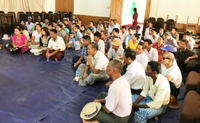 |
Figure: Providing Land Permits to Zone B - Phase 1&2 PAHs
